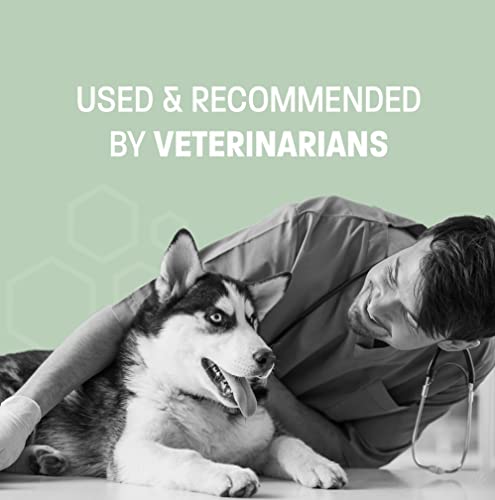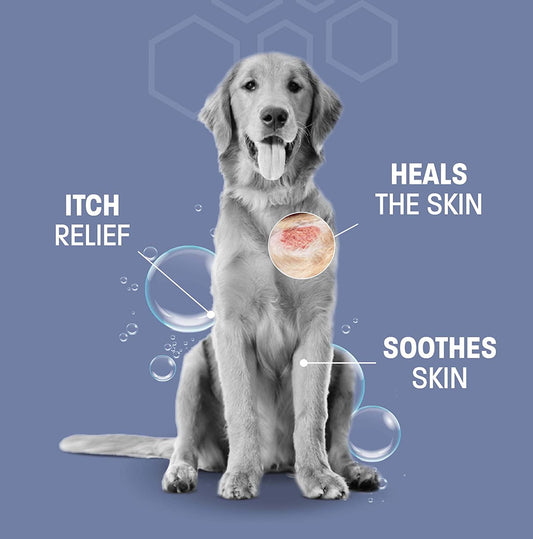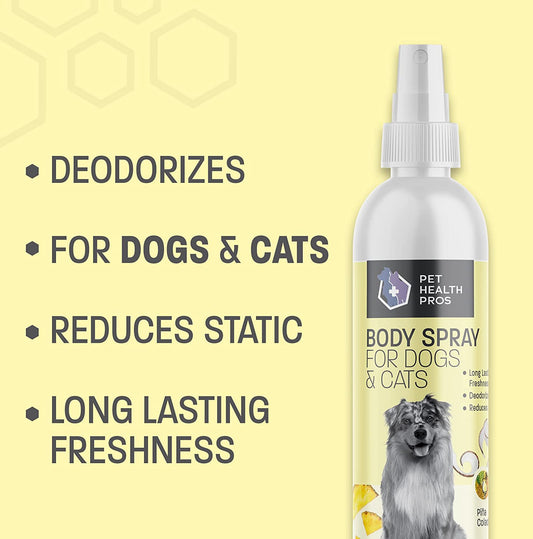When your dog suffers from hot spots, swift action is necessary. Discover how Pet Health Pros' range of medicated solutions provides immediate relief and targeted treatment.
Hot spots on dogs can be a real pain for pet owners. These red, moist, and itchy patches can cause discomfort to our furry friends. Fear not! There are treatments, remedies and cures to help give relief.
The cause of these hot spots is usually allergies, insect bites or skin irritations. They can appear anywhere and worsen quickly if ignored. The dog's licking and scratching can worsen it further.
Topical medication can help. This includes antifungal or antibacterial creams applied directly. These medicines reduce swelling, prevent infection and help heal.
A special shampoo can also be used. It contains oatmeal or aloe vera, which soothe itching and redness. Bathing regularly with this shampoo can help stop hot spots.
In serious cases, oral antibiotics might be needed. This eliminates bacteria from within the dog's body, helping resolve the issue.
What are canine hot spots?
Canine hot spots are a common skin problem. They look like red, painful patches that can be warm and even ooze or develop crusts. Allergies, insect bites, or infections can cause them. Dogs with thick fur or allergies are more prone. Itching and scratching makes it worse.
To give relief, clean the area gently and trim the hair. Ask the vet for topical treatment. Address underlying causes too. Diet changes, testing, grooming, and flea control help prevent them.
Early intervention is important. If left untreated, they can become severe infections. Check your pup's skin for signs of itchiness or redness. Act quickly for their comfort and happiness.
Understanding the causes of hot spots in dogs
Hot spots in dogs can be a source of great discomfort and concern for pet owners. These are inflamed patches of skin, often caused by allergies, insect bites, or excessive licking and scratching. It is important to identify the cause.
Allergies are often the main culprit behind hot spots. Dogs can be sensitive to things like food, pollen, dust mites, or substances. This can lead to them scratching or biting the skin, which then causes hot spots.
Fleas and ticks can also cause hot spots. These parasites cause itching and irritation, leading dogs to scratch or chew their fur. This can create an environment for hot spots to form.
Poor grooming habits and skin conditions can contribute too. If coats are not maintained, moisture can be trapped near the skin surface. This is perfect for bacteria and fungi to breed. Certain breeds with thick coats may also be more likely to get hot spots, as there is less airflow around the skin.
To help prevent hot spots, it is important to identify allergies, regularly check for parasites, and maintain proper grooming practices. Addressing the root cause is key to providing relief and a healthy furry companion.
Signs and symptoms of hot spots in dogs
Look out for these tell-tale signs of hot spots in your pup: intense itching, red/inflamed skin, hair loss, discharge/oozing, a stinky smell, and pain/discomfort. Don't ignore it - take immediate action to give your pooch the relief they deserve!
Note any unique behaviors and seek vet advice to ensure appropriate treatment. Ignoring the issue may lead to further complications, so act fast and provide your beloved canine with soothing comfort from their hot spot troubles.
Step-by-step guide for addressing canine hot spots
Hot spots on your pup's skin can be a real pain for them. Here's a step-by-step guide to help get rid of them and get your furry friend feeling better!
- Identify the area: Look closely at their skin for any red, irritated, or inflamed spots.
- Cleanse the area: Gently clean the spot with antiseptic or warm water. Pat dry with a clean towel.
- Trim the fur: Use blunt-ended scissors to trim the fur around the spot.
- Apply topical treatment: Ask your vet for the right treatment to put on the spot. This can include antibiotic ointment, hydrocortisone cream, or soothing spray.
- Stop licking/scratching: Dogs often worsen hot spots by licking or scratching them. To prevent this, use an Elizabethan collar or cover the area with a bandage until it heals.
- Monitor & seek help: Keep an eye on the spot and watch for any improvement or worsening. If no improvement in a few days or if the spot gets worse, get help from a vet.
It's important to know that every pup is different, so follow your vet's advice on how to treat and how long to treat. Also, provide a comfortable and stress-free environment. Give them fresh water, good food, and plenty of rest.
Early intervention is key when it comes to hot spots. If left untreated, they can lead to more serious infections and discomfort. Don't wait to get help. Your pup's health is worth it.
Take action now and help your pup find relief. They'll thank you, and you'll have peace of mind knowing you did the best for them.
Natural remedies for hot spots in dogs
- Aloe vera gel has anti-inflammatory properties and can reduce itching and swelling. Put a small amount directly on the hot spot.
- Apple cider vinegar and water diluted together can be applied with a clean cloth or cotton ball. This helps to restore the skin's pH balance and has antibacterial effects.
- Soak a cotton ball in witch hazel and use it to dab the hot spot. It's an astringent and dries out the area, reducing inflammation.
- Coconut oil can be spread on the hot spot to moisturize and ease discomfort. It also has antimicrobial features which help prevent infection and aid healing.
- An Epsom salt bath can give relief from itching, reduce inflammation, and cleanse the hot spot. Let your dog soak for 10 minutes.
- It's important to identify and address the root of the hot spot. This may be allergies or fleas. Furthermore, grooming your dog and keeping their skin clean can prevent future hot spots.
- Throughout history, honey has been used as a natural remedy for skin ailments in animals, including hot spots. Ancient Egyptians thought honey was a powerful healer due to its antibacterial elements. Natural remedies have demonstrated their effectiveness in caring for our canine companions.
When to seek veterinary care
When your furry friend has hot spots, it's important to know when to get help from a vet. Time is key as early treatment can stop the condition from getting worse and help your pup find relief fast.
- If the hot spot has signs of infection like pus, redness, or swelling, you must go to a vet straight away.
- If your pup is in severe pain or discomfort, contact a vet for help.
- If the hot spot does not get better or keeps getting worse within a day or two, see a vet.
- If your dog has an existing health issue or a weak immune system, see a vet right away to prevent problems.
- If your dog has had hot spots before, you may need a vet for treatment and prevention.
- If home remedies and store-bought products don't work, go to the vet.
Plus, if you notice other symptoms or strange behavior alongside the hot spot, have a vet check it out to make sure nothing else is wrong.
Till you see a vet, here are some ways to give some relief. Cleaning the area with an antiseptic and drying it helps remove bacteria and moisture. A cold compress reduces inflammation and stops itching. Medicated sprays and creams with hydrocortisone can soothe irritation and help healing.
These temporary fixes don't replace a vet. Seeing one is still the best way to treat hot spots.
Let's sum up our hot spot-fixing plan. Treat and comfort your pup for the best results. Follow our steps and give your pooch the relief they need.
Combating hot spots requires dedicated care. With Pet Health Pros, find the perfect ally in restoring your dog's comfort and health.
Now, for extra info. It's vital to find the cause of the hot spot. Speak to a vet, and discover if it's allergies, fleas, or a skin problem. Clean your pup's environment and practice good cleanliness. Regular brushing, proper food, and exercise too – all help keep the immune system strong, and avoid hot spots.
And, one last tip: patience. Hot spots take time. Show your pup love and care. Soon enough they'll be back to their happy self.
So, there you have it. Everything you need to know about solving canine hot spots. With the right treatment, prevention, and determination, your furry buddy will feel better in no time.
Frequently Asked Questions
FAQs about Soothing Relief: Addressing Canine Hot Spots
Q: What are hot spots in dogs?
A: Hot spots, also known as acute moist dermatitis, are localized areas of skin inflammation that are often accompanied by itching, redness, and hair loss in dogs.
Q: How can I treat hot spots on my dog?
A: Treatment for hot spots typically involves first cleaning the affected area with a mild antiseptic solution and then applying a soothing topical medication or spray to relieve inflammation and promote healing. It is advisable to consult a veterinarian for proper diagnosis and treatment recommendations.
Q: Are there any home remedies to help soothe canine hot spots?
A: While it's important to consult a vet, there are some home remedies you can try to provide temporary relief to your dog's hot spots. These include gently washing the area with diluted apple cider vinegar, applying aloe vera gel, or using a chamomile tea compress. However, these remedies may not address the underlying cause, so seeking professional advice is recommended.
Q: Can hot spots in dogs be cured completely?
A: Hot spots can typically be managed and eventually cured with proper treatment, which includes identifying and addressing the underlying cause, preventing further self-trauma by using an Elizabethan collar or bandaging, and providing appropriate medication and care. However, the duration of healing may vary depending on the severity of the hot spot.
Q: What are the common causes of hot spots in dogs?
A: Hot spots in dogs can be caused by various factors, including allergies (such as food or environmental allergies), insect bites, poor grooming habits, underlying skin infections, or excessive moisture trapped in the fur. Identifying the underlying cause is crucial in preventing recurrent hot spots.
Q: How can I prevent hot spots in my dog?
A: To prevent hot spots, it's important to maintain good hygiene and grooming practices, regularly check for any signs of skin irritation or infection, ensure your dog's coat stays dry, and address any allergies or underlying health issues promptly. Regular flea and tick prevention is also crucial, as these parasites can lead to skin irritation and hot spots.








